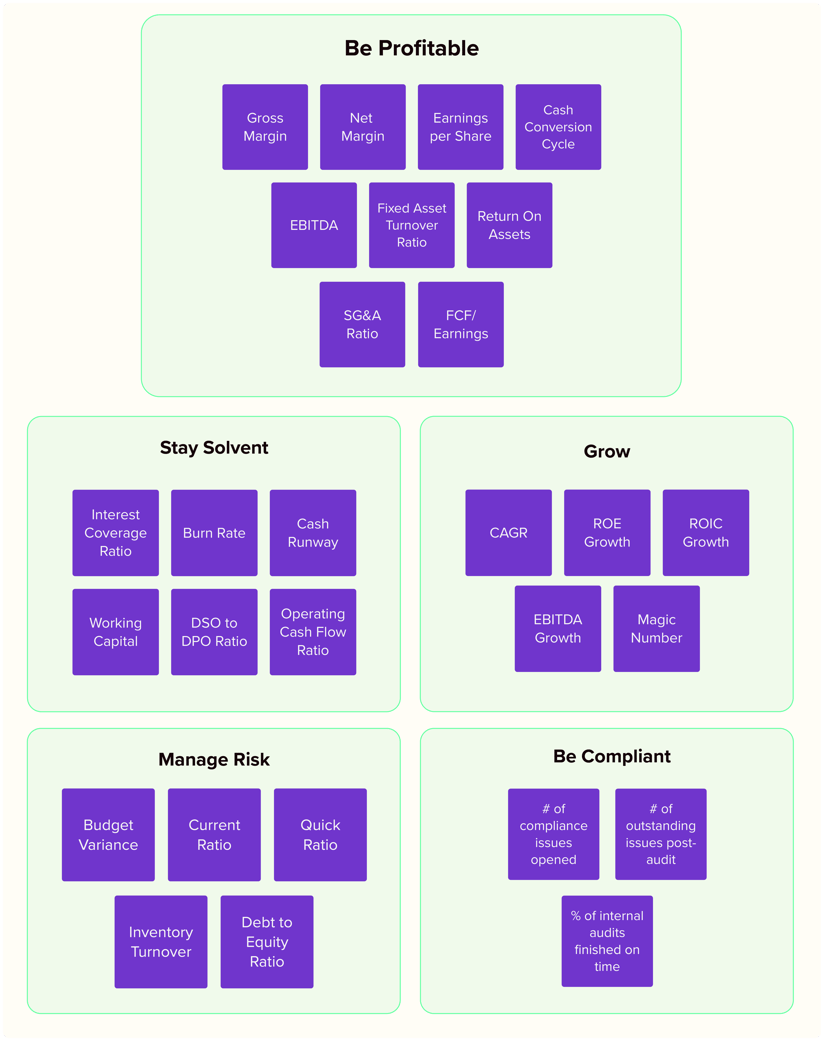As a CFO, your Board and CEO are probably asking you tougher questions than ever. Fumbling an important question because you don't have the right financial KPI is a nightmare you'd rather avoid.
Financial KPIs, or numbers derived from accounting, revenue, and asset data, tell you how your company has performed so far and help you prepare for the future. In short, they tell you where you've been and where you're likely headed.
Identifying the right financial KPIs to track is a critical CFO skill. When wondering which KPIs CFOs must track, you'll usually get hit with a long list of ratios and metrics. However, you must take the time to identify the right KPIs for your business' goals before creating a list of them to track.
Here's how you can categorize and create the right financial KPIs that give you answers when you need them.
Aligning financial KPIs with business goals
"You may select KPIs that are not aligned with the company's strategic objectives, leading to a disconnect between what is measured and what is important for the business," says Chris Martinez, Finance Analytics Manager at The Kraft Heinz Company.
He also points to "focusing solely on lagging indicators, like past quarter sales, instead of incorporating leading indicators, like sales pipeline" as another KPI-related mistake CFOs make.
Modern CFOs must have the skills and data to deliver actionable insights, not mere reports. Your KPIs must help you tell a story to stakeholders if you want to make a positive impact. So how do you align your KPIs with business goals? Bernie Smith, Author of KPI Checklists and Consultant at Made to Measure KPIs, offered this view.
"After running lots and lots of strategy sessions, I realized there are six fundamental strategic objectives that almost every commercial organization strives to achieve," he said when speaking on the CFO Talk podcast. "Be profitable, stay solvent, grow, strive for innovation, manage risk, and be compliant.”
Categorize your KPIs according to these categories, and you'll automatically align them with your business goals. These categories also make sifting through KPI lists easy.
Here are the most important KPIs you must track, categorized per Smith's strategic objectives:

Financial KPIs categorized according to strategic business objectives.
“Be profitable” - Financial KPIs you must track
These financial KPIs tell CFOs how profitable their companies are and how efficiently they’re turning resources invested into profit.
- Gross margin
Your profit after COGS.
Gross Margin = (Revenue - Cost of Goods Sold) / Revenue - Net margin
Your profit after all expenses.
Net Margin = Net Income / Revenue. - EPS
Your earnings per share.
EPS = (Net Income - Dividends on Preferred Stock) / Weighted Average Number of Shares Outstanding - Cash conversion cycle
How soon are you converting inventory to cash?
Cash Conversion Cycle = Days Sales Outstanding (DSO) + Days Inventory Outstanding (DIO) - Days Payables Outstanding (DPO) - EBITDA
Your earnings before interest, depreciation, amortization, and taxes. Investors and Boards track this metric closely, tying funding to it.
EBITDA = Net Income + Interest + Taxes + Depreciation + Amortization - Fixed asset turnover ratio
Sales you're generating on fixed assets.
Fixed Asset Turnover Ratio = Revenue / Net Fixed Assets. - Return on assets
Your ROI on all company assets.
ROA = Net Income / Average Total Assets - SG&A ratio
ROI on employee and workforce expenses.
SG&A Ratio = (SG&A Expenses / Revenue) * 100 - FCF/earnings
How much of your earnings is hard cash that you can use?
Free Cash Flow / Net Income
“Stay solvent” - Financial KPIs you must track
These KPIs measure your ability to meet business expenditures, both operational and capital.
- Interest coverage ratio
Can your earnings cover interest owed?
Interest Coverage Ratio = EBIT / Interest Expense - Burn rate
How quickly are you burning cash?
Burn Rate = (Beginning Cash - Ending Cash) / Number of Months - Cash runway
How many months of cash do you have left?
Cash Runway = Cash Balance / Monthly Burn Rate. - Working capital
Can you meet regular operating expenses?
Working Capital = Current Assets - Current Liabilities - Days Sales Outstanding (DSO) to Days Payables Outstanding (DPO)
How soon do customers pay you versus how soon you pay suppliers? Another way to look at this is "How soon cash enters versus how soon it leaves."
DSO to DPO Ratio = DSO / DPO - Operating cash flow ratio
Can your cash flow cover current liabilities?
Operating Cash Flow Ratio = Operating Cash Flow / Current Liabilities
“Grow” - Financial KPIs you must track
These KPIs for CFOs tell them how fast and efficiently their business is growing.
- CAGR rates
Compounded growth rate in earnings and book value.
CAGR = (Ending Value / Beginning Value) ^ (1 / Number of Years) - 1 - ROE growth
Return on equity growth or how much are your investors' earnings growing (or decreasing)?
ROE Growth = (Current ROE - Prior ROE) / Prior ROE - ROIC growth
How are returns on invested capital (equity and debt) growing (or slowing)?
ROIC Growth = (Current ROIC - Prior ROIC) / Prior ROIC - EBITDA growth
How is your EBITDA growing (or slowing)?
EBITDA Growth = (Current EBITDA - Prior EBITDA) / Prior EBITDA - Magic number
Relevant for SaaS companies. What is the ROI on your sales and marketing spend (earnings/S&M spend)? Are they contributing efficiently to growth?
Magic Number = Current quarter’s revenue - Previous quarter’s revenue) / Previous quarter’s Sales and Marketing Expense
“Manage risk” - Financial KPIs you must track
These financial KPIs measure whether your business is exposed to undue risk.
- Budget variance
Are your budget actuals close to projections?
Budget Variance = Actual Amount - Budgeted Amount - Current ratio
Do current assets cover your current liabilities?
Current Ratio = Current Assets / Current Liabilities - Quick ratio
Do quickly converted current assets (everything excluding inventory and a percentage of AR) cover current liabilities?
Quick Ratio = (Current Assets - Inventory) / Current Liabilities - Inventory turnover
Are you stockpiling too much inventory?
Inventory Turnover = Cost of Goods Sold / Average Inventory - Debt to equity
How much of your growth is debt-fueled? Is this sustainable through volatility?
Debt to Equity Ratio = Total Debt / Shareholders' Equity
“Be compliant” - Financial KPIs you must track
These CFO KPIs measure whether your internal controls are keeping you compliant.
- Number of compliance issues opened
Are your internal risk controls working? - Number of outstanding issues post-audit
How many issues should your team address? - Percent of internal audits finished on time
Are internal audits efficient?
Tips to create and maintain financial KPIs
Look laterally
Often, true business drivers cannot be measured and as a result, you cannot create a KPI for it. Smith advises against giving up on it.
"Do not reject something just because it appears to be impossible to measure," he says.
"Think laterally. Take a look at the measure and think about what else happens when that thing happens."
Sometimes, a lack of measurement is a data problem. "Evaluate the data sources available and the quality of the data," counsels Martinez. " This ensures accurate and reliable measurement."
Structuring your finance department correctly by hiring for the right roles helps you assimilate insights in your data and think outside the box in these situations.
Rate your KPIs’ effectiveness
Your business will evolve and your KPIs must change with it. Periodically reviewing your KPIs for effectiveness is a great way to ensure you're measuring the right strategic goals in your business.
Kirk Kappelhoff, Director of Strategic Finance at Drivetrain, lays out a simple model to figure out KPI effectiveness. “The single most useful method in determining how relevant a KPI is to your organization is by creating a tornado chart in your forecast model,” he says. “For example, perhaps we have a list of 3 common KPIs: Customer Lifetime Value (CLV), Customer Acquisition Cost (CAC), and Churn Rate.”
“Now, if we flex these metrics up or down by a fixed range of say, 10%, we can look at the impact to net income and see which affected net income the most.” The chart below demonstrates the effect on those KPIs on net income.
In this example, CLV has the biggest impact and is the most critical KPI to track, followed by CAC and Churn Rate.
Smith lays out a detailed approach to sifting, shortlisting, and scoring KPIs. While the full process might seem a bit much (even if you use AI assistance), Smith's recommendations for categorizing KPIs based on data availability are relevant.
"If you can measure something that others find hard to measure, then it can be a ‘gold bar’ for your business," he says. "Keep an eye on these and commit to moving one or two into the ‘Primary KPIs’ bucket in the future."
Account for international context
When operating internationally, there are additional layers of complexity that CFOs must be aware of.
For instance, currency risk management becomes all-important when trading across international borders. Setting KPIs like FX budget rates is critical to achieving this goal.
"Cultural relevance, compliance with local laws, and ensuring you've localized KPIs are essential tasks." Martinez adds.
Referring to compliance, he points out that data collection practices that fuel a KPI might put you on the wrong side of local data privacy laws. Similarly, you must develop localized KPIs that reflect the needs of a local market and balance them with global standardized KPIs.
Kappelhoff adds, “The most important piece of judging KPIs is ensuring an apples-to-apples comparison. If there is a tax implication or policy-based regulatory impact to that KPI it will have to be adjusted in one region or the other to ensure the apples-to-apples comparison is still valid.”
He lists an example. “If one country calculates gross margin to include consulting fees, but another country does not then we do not have an apples-to-apples comparison. So consulting fees would either have to be added to one region or subtracted from the other to get a valid comparison of gross margin across regions.”
Context across geographies matters. Make sure you are not imposing blanket KPIs on your business that measure nothing.
Embrace electronic dashboards
Navigating a labyrinth of spreadsheets and tabs for data is the last thing you want. That’s where electronic dashboards step in, helping you quickly gather and review your KPIs in a single pane of glass, summarizing business performance. Here are a few examples of KPI dashboards designed specifically for CFOs.
A financial dashboard with key financial information for CFOs. Courtesy: Pigment
A financial dashboard highlighting account payables. Courtesy: Tableau
A CFO dashboard highlighting expenses related to headcount. Courtesy: Drivetrain
The bottom line
As a CFO, KPIs are the nuts and bolts of your success. When used effectively, KPIs will help you make smarter, data-driven decisions, spot business risks in advance and build agility in your processes.
However, to avoid diluting your focus, cherry-pick the KPIs you deem most relevant to your company’s priorities and goals.
And for an added efficiency, look into financial tools that would provide you with instant access to accurate data in real-time.
